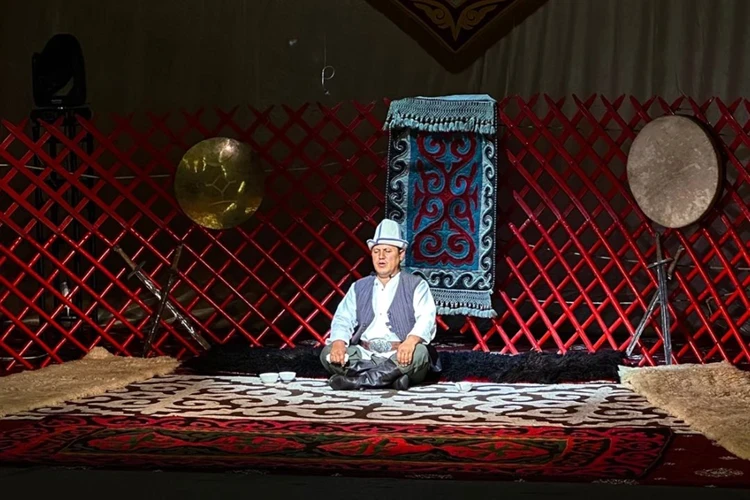
The incorporation of Kyrgyzstan into Russia was of great significance not only for the internal political, economic, and social development of Kyrgyz society but also contributed to progressive changes in its culture.
Kyrgyz national culture (oral folk poetry, decorative and applied arts, visual arts, musical creativity, etc.), which developed over centuries in the conditions of nomadic life, owes much to folklore. The unique monument of the oral folk creativity of the Kyrgyz is the heroic epic "Manas," which tells of the struggle of the Kyrgyz, led by the legendary Manas, for their independence.
Outstanding manaschy. "Manas," which originated in ancient times, has been preserved and conveyed to this day by the storytellers of the epic—manaschy—who, throughout centuries, enriched the content of the epic with new scenes, fragments, and episodes. Among them are such famous manaschy in the Kyrgyz people as Keldibek, Bekmurat (Balik), Tynybek, Choyuke, Sagymbay, Sayakbay.
These were great storytellers, possessing a broad worldview, exceptional acting talent and imagination, phenomenal memory, and a keen sense of the psychology of their listeners. Only such extraordinary individuals could continuously captivate a large audience for many hours, making them experience the joy of victories and the bitterness of defeats of beloved folk heroes through their unique recitation, emotions, movements, and gestures. According to eyewitnesses, when the renowned manaschy Tynybek recited the epic "Manas," people felt as if they were truly hearing the rumble of thunder, the beat of drums, and could see Manas proudly marching into battle with his forty knights, experiencing all the twists and turns of his fight with the sworn enemy Konurbay or how the famous Koshoy defeats Joloy.
Thanks to them, the manaschy, the epic still nourishes the people with spiritual strength, teaches and instills in them a love of freedom, humanity, and love for the Motherland.
In the 19th century, alongside "Manas," small folk epics such as "Er Toshtuk," "Kodzhozhash," "Janush Bayish," "Er Tabyldy," "Zhanil Myrza," and others, which also focused on the struggle against foreign invaders, were widely popular among the Kyrgyz and further developed.
Poetry of akyns. During this period, the art of akyns—improvising singers—flourished, demonstrating their skills in competitions known as aitys. Talented akyns Jenzhok, Toktogul, Eshmambet, Barpy created beautiful, deeply meaningful works reflecting the life issues of the people, their powerless situation, dreams, and hopes for a better fate.
A whole galaxy of akyn-thinkers emerged, in whose works there was an attempt to comprehend and clearly depict the life of their time, artistically presenting the future. Among them were Kalygul with his poem "Akyr zaman" ("End of the World") and Arstanbek with the work "Tar zaman" ("Difficult Times"). These akyns prophesied in their verses about significant changes in the life of the people, predicting many troubles and trials. Unfortunately, life confirmed their predictions. Therefore, people called them akyns-prophets, zamanists (from the word zaman—time).
Akyn poetry was oral creativity. However, some outstanding akyns, such as Moldo Niyaz, Moldo Kylch, Togolok Moldo, not only masterfully performed their works publicly but also recorded them, as they were literate.

Moldo Niyaz received his education in Muslim educational institutions in Fergana and Kashgar. In his sanats (poems), which were examples of the instructive genre, he wrote about life and death, good and evil. However, history has preserved only a few of his works.
In 1911, the poem "Zilzala" ("Earthquake") by Moldo Kylch was published in Kazan, in which the author managed to convey the strength of the tragedy of the people who experienced a terrible natural disaster—the earthquake that occurred in December 1910 in Chon-Kemin. This was the first book published in the Kyrgyz language.
The creativity of another famous akyn—Togolok Moldo (Baimbet Abdrakhmanov)—is unique. His meeting with the great manaschy Tynybek had a significant impact on the talented young man: he grasped the depth and beauty of the epic "Manas," learned it, and then recorded it. Tynybek recognized his original talent and named him Togolok Moldo ("round-faced scholar"). Indeed, his creativity is multifaceted: he wrote lyrical songs of lament, songs of sorrow about the hard fate of the people, while at the same time the akyn celebrated the beauty and richness of the nature of Kyrgyzstan, calling on the youth to love their homeland. His fables, in which he depicted the lives of people through the images of animals and birds, were very popular: he ridiculed greed and avarice, cowardice and the corruption of the rich, while praising the intelligence and hard work, dignity and courage of the common people.
Musicians. Musical art developed in close connection with akynship. Remarkable melodists Kurankey, Niyazaly, Karamoldo, Boogachy, Ibrai applied various musical instruments in their creativity: komuz, kyiyak (a type of violin), ooz komuz (jaw harp), choor (pipe), sabyzgy (flute). They did not use notes: their innate sense of music and natural talent allowed them to retain dozens of melodies and tunes in their memory. The works of these outstanding folk talents are still part of the repertoire of modern musicians and musical groups.
















































